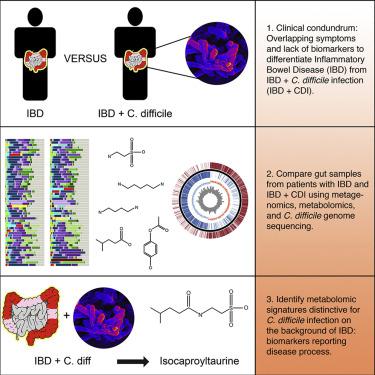Cell Host & Microbe ( IF 20.6 ) Pub Date : 2020-08-20 , DOI: 10.1016/j.chom.2020.07.020 Frederic D Bushman 1 , Maire Conrad 2 , Yue Ren 3 , Chunyu Zhao 4 , Christopher Gu 1 , Christopher Petucci 5 , Min-Soo Kim 5 , Arwa Abbas 6 , Kevin J Downes 7 , Nina Devas 4 , Lisa M Mattei 4 , Jessica Breton 2 , Judith Kelsen 2 , Sarah Marakos 4 , Alissa Galgano 4 , Kelly Kachelries 4 , Jessi Erlichman 4 , Jessica L Hart 8 , Michael Moraskie 4 , Dorothy Kim 4 , Huanjia Zhang 4 , Casey E Hofstaedter 4 , Gary D Wu 9 , James D Lewis 9 , Joseph P Zackular 6 , Hongzhe Li 3 , Kyle Bittinger 4 , Robert Baldassano 2

|
Children with inflammatory bowel diseases (IBD) are particularly vulnerable to infection with Clostridioides difficile (CDI). IBD and IBD + CDI have overlapping symptoms but respond to distinctive treatments, highlighting the need for diagnostic biomarkers. Here, we studied pediatric patients with IBD and IBD + CDI, comparing longitudinal data on the gut microbiome, metabolome, and other measures. The microbiome is dysbiotic and heterogeneous in both disease states, but the metabolome reveals disease-specific patterns. The IBD group shows increased concentrations of markers of inflammation and tissue damage compared with healthy controls, and metabolic changes associate with susceptibility to CDI. In IBD + CDI, we detect both metabolites associated with inflammation/tissue damage and fermentation products produced by C. difficile. The most discriminating metabolite found is isocaproyltaurine, a covalent conjugate of a distinctive C. difficile fermentation product (isocaproate) and an amino acid associated with tissue damage (taurine), which may be useful as a joint marker of the two disease processes.
中文翻译:

艰难梭菌感染与小儿炎症性肠病相互作用的多组学分析。
患有炎症性肠病 (IBD) 的儿童特别容易感染艰难梭菌(CDI)。IBD 和 IBD + CDI 有重叠的症状,但对独特的治疗有反应,突出了对诊断生物标志物的需求。在这里,我们研究了患有 IBD 和 IBD + CDI 的儿科患者,比较了肠道微生物组、代谢组和其他指标的纵向数据。在这两种疾病状态下,微生物组都是失调的和异质的,但代谢组揭示了疾病特异性模式。与健康对照组相比,IBD 组的炎症和组织损伤标志物浓度增加,代谢变化与 CDI 易感性相关。在 IBD + CDI 中,我们检测到与炎症/组织损伤相关的代谢物和艰难梭菌产生的发酵产物. 发现的最具鉴别力的代谢物是异己酰牛磺酸,一种独特的艰难梭菌发酵产物(异己酸盐)和与组织损伤相关的氨基酸(牛磺酸)的共价结合物,可用作两种疾病过程的联合标志物。










































 京公网安备 11010802027423号
京公网安备 11010802027423号